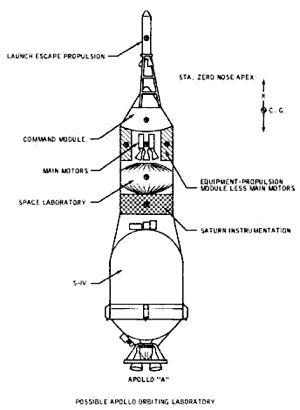
Home - Search - Browse - Alphabetic Index: 0- 1- 2- 3- 4- 5- 6- 7- 8- 9
A- B- C- D- E- F- G- H- I- J- K- L- M- N- O- P- Q- R- S- T- U- V- W- X- Y- Z
Apollo A
 Apollo AOL Credit: NASA |
Status: Study 1961.
It was specifically designed for long-duration operations in space; to conduct re-entry tests at near-parabolic speeds; and then for manned circumlunar missions.
At the time of the Apollo bidder's conference in August 1961 an evolutionary approach to the Apollo program was expected. After completion of the Mercury project both the Apollo spacecraft and Saturn launch would gradually fly multi-man crews on a series of ever-more ambitious scientific and technological missions in earth-moon space. This program would begin with manned earth satellite flights of extended lifetime, proceed to lunar circumnavigation, to lunar satellite flights, and ultimately to the lunar landing. Although the Apollo A designation was applied only to the first unmanned Apollo tests at this time, we would use the term here to designate the Apollo design and program plan as envisioned by NASA prior to the Apollo bidder's conference in the summer of 1961.
The return to earth and the recovery of the manned spacecraft were important parts of these missions. The development of the Apollo spacecraft was to proceed in several phases. Each phase, to the extent possible, would serve as qualification for the subsequent phase. The objectives of Apollo Phase A was:
- Qualification of systems and features for the lunar missions within the constraints or the environment of earth satellite orbits of up to 500 km altitude by manned flights.
- Qualification of the re-entry heat protection for the lunar missions in unmanned re-entry tests from super-circular and near-parabolic velocities.
- Study of physiological and psychological reactions and capabilities of a multiman crew in the space environment during extended periods of time (at least two weeks). In the adapter between the Saturn second stage and the Apollo spacecraft, as an integral part, was a section to be used as an orbiting laboratory. Preliminary designs indicated this laboratory would be a cylindrical section about 3.9 m in diameter and 2.4 m in height. The laboratory would provide the environment and facilities to conduct scientific experiments related to manned operation of spacecraft. Experiments that might be conducted from an Earth-orbiting laboratory included: astronomical observations; monitoring the Sun's activity; testing man's ability to work outside the vehicle; zero-g testing; and micrometeoroid impact study.
- Development of flight and ground operational techniques and equipment for the support of space flights of extended periods
- Conduct of experimental investigations as needed to acquire information for the subsequent lunar missions.
The two-stage Saturn C-I launch vehicle system would be utilized to carry the Apollo A spacecraft into the low earth-satellite orbits and to accelerate the capsule only to re-entry trajectories during the Apollo A phase.
The mass breakdown of the Apollo A earth-orbit version was nearly 1/3 less than that of the later Apollo capsule final design:
- Command Module: 3600 kg
- Equipment-Propulsion Module (less Main Motors): 1600 kg
- Main Motors: 1300 kg
- Space Laboratory: 1400 kg
- Launch Escape Propulsion: 1700 kg (separated after first stage burn-out)
- Total Launch Weight: 9500 kg
- Total Weight in Low Earth Orbit: 7800 kg
As of the summer of 1961 it was planned that Apollo A boilerplate flights in the earth-orbit configuration would take place in October/December 1963 using Saturn C-1's SA-7 and SA-8. SA-9 and SA-10 would launch 3400 kg capsule-only payloads in February-April 1964 to near parabolic velocities in tests of the capsule's hypersonic aerodynamics and heat shield. These prototype capsules would be equipped with parachutes and be recovered.
These proving tests would be followed by Apollo A manned earth orbit space laboratory missions in the 1965-1967 period. Manned circumlunar flights would occur at the same time. The booster for such missions was originally intended to be the Saturn C-2. This was changed to the Saturn C-3 in June 1961 when it became clear the Apollo spacecraft would weigh too much for such missions. The C-3 in turn was cancelled in favor of the C-5, and discussion of circumlunar Apollo disappeared by the end of 1962.
Family: Manned Circumlunar, Space station, Space station orbit. Country: USA. Launch Vehicles: Saturn I. Agency: NASA.
1961 May 18-31 - .
- Apollo A - .
Nation: USA.
Related Persons: Gilruth.
Spacecraft Bus: Apollo CSM.
Spacecraft: Apollo A.
Space Task Group Director Robert R. Gilruth informed Ames Research Center that current planning for Apollo 'A' called for an adapter between the Saturn second stage and the Apollo spacecraft to include, as an integral part, a section to be used as an orbiting laboratory. Preliminary in-house configuration designs indicated this laboratory would be a cylindrical section about 3.9 m in diameter and 2.4 m in height. Additional Details: here....
Back to top of page
Home - Search - Browse - Alphabetic Index: 0- 1- 2- 3- 4- 5- 6- 7- 8- 9
A- B- C- D- E- F- G- H- I- J- K- L- M- N- O- P- Q- R- S- T- U- V- W- X- Y- Z
© 1997-2019 Mark Wade - Contact
© / Conditions for Use